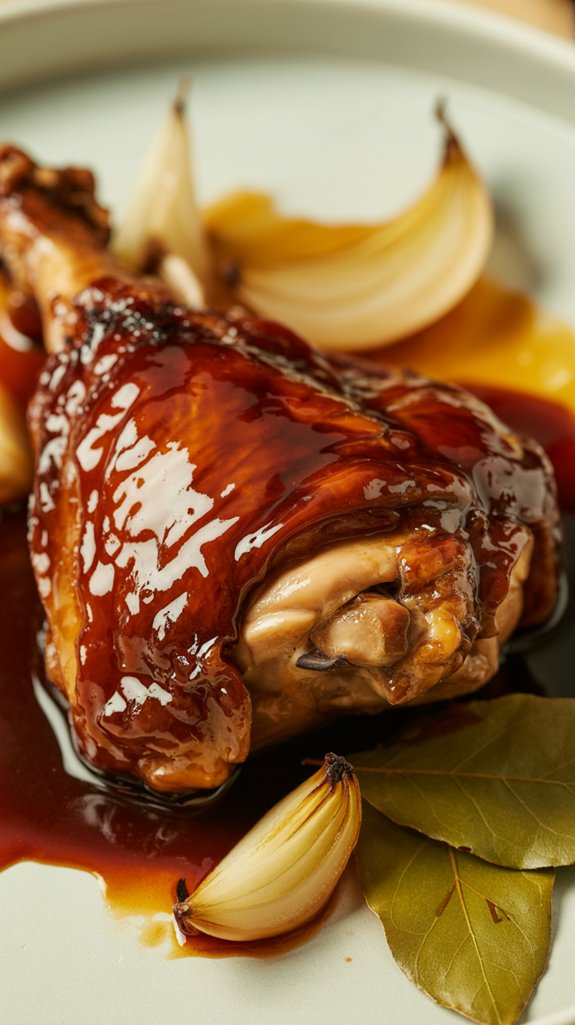Why You’ll Love This this Hearty Filipino Chicken Asado
This Filipino chicken asado transforms just five simple ingredients into something that’ll make your kitchen smell like pure comfort food heaven.
The combination of soy sauce, lemon juice, and tomatoes creates this amazing savory-tangy sauce that soaks right into the tender chicken – and honestly, who doesn’t love a one-pot meal that practically cooks itself?
You just toss everything together, let it simmer away for an hour, and boom, you’ve got this hearty, soul-warming dish that tastes like it took way more effort than it actually did.
Ingredients List
You only need five ingredients to create this incredibly flavorful Filipino comfort food that’ll have everyone asking for seconds.
- 3 lbs whole chickens
- 1 (14 ounce) can whole tomatoes, with sauce
- 1/2 large onion, sliced
- 1/2 cup soy sauce
- 1/4 cup lemon juice
- Protein powerhouse – Three pounds of chicken gives you plenty of lean protein to feed a hungry family
- Vitamin boost – Those tomatoes pack vitamin C and lycopene, while the onions add some beneficial antioxidants
- Sodium watch – The soy sauce does bump up the sodium content quite a bit, so if you’re watching your salt intake, you might want to use a low-sodium version
- Gluten-free friendly – Just swap in gluten-free soy sauce and double-check your canned tomatoes, and you’re all set for anyone avoiding gluten
- Start with the chicken – Place your 3 pounds of whole chicken in a large pot.
- Add the flavor base – Pour in the entire 14-ounce can of whole tomatoes with sauce.
- Layer in aromatics – Add your sliced half onion for that sweet, savory depth.
- Pour in the soy sauce – Add the full 1/2 cup of soy sauce for that signature umami flavor.
- Finish with citrus – Squeeze in 1/4 cup of fresh lemon juice to brighten everything up.
- Bring to a boil – Turn heat to high and let everything come to a rolling boil.
- Cover and simmer – Reduce heat to low, cover the pot, and let it simmer for 1 hour or until the chicken is fork-tender.
- Serve it up – Ladle over steamed rice or boiled potatoes to soak up all that incredible sauce.
- Onion options – Yellow, white, sweet onions, they all play nice in this recipe, and honestly, I’ve never met an onion that didn’t want to hang out in a braising pot.
- Go fancy with herbs – A few bay leaves or some fresh thyme sprigs during the simmering phase will make your kitchen smell like you actually know what you’re doing.
- Rice is the MVP here – Jasmine, basmati, or even plain old long-grain white rice will soak up that gorgeous braising liquid like a sponge, and honestly, isn’t that what we’re all here for.
- Mashed potatoes work their magic too – They turn this into pure comfort food territory, the kind that makes you want to change into sweatpants and call it a night.
- Steamed vegetables keep things balanced – Green beans, broccoli, or snap peas add some color and crunch, plus they make you feel slightly better about ignoring your vegetables all week.
- Crusty bread for the sauce addicts – Because someone in your family will absolutely want to mop up every last drop of that tomato-soy goodness, and you know what, they’re not wrong.
- Simple side salad cuts through the richness – A basic mixed greens situation with a light vinaigrette helps balance out all that savory braised goodness.
- Don’t skip the browning step – Even though the recipe doesn’t mention it, giving that chicken a quick sear in the pot before adding liquids creates way more flavor depth, and honestly, who doesn’t want their dinner to taste like it came from someone who actually knows what they’re doing.
- Keep the lid slightly cracked during simmering – This prevents the sauce from getting too watery while still keeping everything moist, because nobody wants chicken that tastes like it went swimming in a bland tomato pool.
- Test for doneness with a thermometer – The thickest part of the thigh should hit 165°F, and if you’re one of those people who eyeballs everything, just make sure the juices run clear when you poke it with a fork.
- Let it rest for 10 minutes before serving – This gives the juices time to redistribute, plus it saves you from that awkward moment when you’re frantically fanning your mouth because you couldn’t wait.
- Taste and adjust the sauce – Sometimes you need a splash more soy sauce for saltiness or an extra squeeze of lemon for brightness, because recipes are more like guidelines than actual rules anyway.
- Use a heavy-bottomed pot – It distributes heat more evenly and prevents that dreaded burnt-bottom situation that makes your whole kitchen smell like regret.
- Calories per serving: Approximately 420-450 calories (based on 6 servings)
- Protein: 35-40 grams per serving from the chicken, making this a protein powerhouse
- Fat: 18-22 grams, mostly from chicken skin and dark meat
- Carbohydrates: 8-10 grams, primarily from tomatoes and onions
- Sodium: 1,200-1,400mg per serving – that’s about 60% of daily recommended intake
- Fiber: 2-3 grams from the vegetables
- Vitamin C: Good source from lemon juice and tomatoes
- Iron: Moderate amount from chicken, especially dark meat portions
- Potassium: 600-700mg from chicken and tomatoes
- Sugar: 6-8 grams, naturally occurring from tomatoes and onions
- Cholesterol: 85-95mg per serving
- Calcium: Small amounts from bones if using bone-in chicken
Step by Step Directions

Making this Filipino Chicken Asado couldn’t be simpler – it’s a true one-pot wonder that practically cooks itself.
For restaurant-quality results, consider investing in commercial kitchen equipment that can handle larger batches and provide consistent heat distribution.
Substitutions and Variations
Additional Things to Serve With This Dish
This saucy, tender chicken practically begs for some good company on the plate.
Cooking Tips & Tricks (Chef’s Notes)
Getting this chicken just right comes down to a few key moves that’ll save you from any kitchen disasters.
Nutritional Facts
This Filipino Chicken Asado delivers a solid balance of protein and flavor, though the sodium content runs high due to the soy sauce and canned tomatoes.
Fun “Did You Know?”
Ever wonder why Filipino Asado tastes so different from Chinese char siu despite sharing the same name?
I’ll let you in on a fascinating secret: Filipino asado evolved from Spanish colonial influence, not Chinese cuisine! The Spanish brought their love of tomato-based stews, which explains why we use canned tomatoes instead of hoisin sauce.
Here’s another cool fact: traditional Filipino asado often includes star anise and bay leaves, giving it that distinctive aromatic profile.
The soy sauce addition came later through Chinese trade, creating this beautiful fusion that’s uniquely Filipino. It’s culinary history in every bite!





